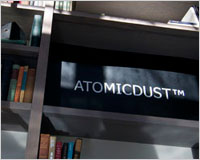 A St. Louis design group announced a special gathering at a local design studio for a program entitled, "Educational Night: The Business of Design." The evening's program was hosted by a local design studio that is making leaps and bounds in the local and national scene, so it didn’t take long for the reservations to pour in until there were no more spaces to be had.
The studio, Atomicdust, certainly seemed to have the inside information on success, having been recognized by the One Show, Step, Print, and Create Magazine as well as local and regional Addy awards, so getting some inside information was highly coveted by members of the design group.
The notice read: "Jesse McGowan of Atomicdust is going to talk about the business of design, focusing on what we all went to school for vs. what is usually required of designers in the real world, especially those who freelance or start their own companies. He will touch on pricing strategy, client management and then talk about a couple resources that are out there for small firms/freelancers."
Obviously, no one could turn such information down. The promise of free beer, wine, and soda certainly didn’t hurt, either.
Mr. McGowan, the Account Director, is a pleasant and jovial guy who started his talk by admitting to being a “graphic designer who learned the business side of design.” One of my big disappointments in our hfield is that most designers, being right-brainers, don’t care to learn being businesspeople, so I immediately perked up to hear what he had to say.
A St. Louis design group announced a special gathering at a local design studio for a program entitled, "Educational Night: The Business of Design." The evening's program was hosted by a local design studio that is making leaps and bounds in the local and national scene, so it didn’t take long for the reservations to pour in until there were no more spaces to be had.
The studio, Atomicdust, certainly seemed to have the inside information on success, having been recognized by the One Show, Step, Print, and Create Magazine as well as local and regional Addy awards, so getting some inside information was highly coveted by members of the design group.
The notice read: "Jesse McGowan of Atomicdust is going to talk about the business of design, focusing on what we all went to school for vs. what is usually required of designers in the real world, especially those who freelance or start their own companies. He will touch on pricing strategy, client management and then talk about a couple resources that are out there for small firms/freelancers."
Obviously, no one could turn such information down. The promise of free beer, wine, and soda certainly didn’t hurt, either.
Mr. McGowan, the Account Director, is a pleasant and jovial guy who started his talk by admitting to being a “graphic designer who learned the business side of design.” One of my big disappointments in our hfield is that most designers, being right-brainers, don’t care to learn being businesspeople, so I immediately perked up to hear what he had to say.
On learning business…
Jesse spoke of his start as a designer and being forced through increasing responsibility to the studio of having to learn to deal with clients. This is not just talking to people but knowing the nuances of negotiations, trouble-shooting, explanations, and everything else involved in running projects as the client contact. Jesse adds: “My role was moving from that of designer to account executive, strategist, new business developer, manager and HR. While I felt more creative than ever, I was forced to learn an entirely new set of skills that I’d never been trained on before. It was a terrifyingly formative transition that has left me forever hungry for new ways to continue to grow.” More on Jesse: After nearly nine years with Atomicdust, Jesse has extensive experience in both the development and management of a variety of media. As Director of Account Services, he prides himself on an almost obsessive attention to detail and keen instinct for guiding project teams. Jesse always brings a unique perspective to the table and encourages Atomicdust’s internal team and clients alike to look at projects from new angles in order to produce standout results. “Jesse is", he writes, “a driving force behind many projects at Atomicdust and behind the wheel of a Honda Civic.” I told you he was jovial!
Mike Spakowski, Principle/Creative Director at Atomicdust and wrangler of a talented crew, relates about having Jesse handling client’s accounts:
“As a firm grows, the role of a principal changes from design focused to design and business focused. It can be difficult to focus on both. People get involved in this industry because they are passionate about design and creativity. But a person goes from being a producer of design to running a design producing business.”
More on Jesse: After nearly nine years with Atomicdust, Jesse has extensive experience in both the development and management of a variety of media. As Director of Account Services, he prides himself on an almost obsessive attention to detail and keen instinct for guiding project teams. Jesse always brings a unique perspective to the table and encourages Atomicdust’s internal team and clients alike to look at projects from new angles in order to produce standout results. “Jesse is", he writes, “a driving force behind many projects at Atomicdust and behind the wheel of a Honda Civic.” I told you he was jovial!
Mike Spakowski, Principle/Creative Director at Atomicdust and wrangler of a talented crew, relates about having Jesse handling client’s accounts:
“As a firm grows, the role of a principal changes from design focused to design and business focused. It can be difficult to focus on both. People get involved in this industry because they are passionate about design and creativity. But a person goes from being a producer of design to running a design producing business.”
 A little more about Mike: More than eleven years after founding Atomicdust, Mike is actively involved in day-to-day design strategy, art direction and studio management. As Creative Director, his drive for design excellence, collaborative attitude and even-keeled temperament set the tone at Atomicdust, which is obviously a fun and energetic workplace.
It is rare that a creative can step up and handle the left-brain business that comes with being alert and savvy when dealing with clients. Both Jesse and Mike seem to have the personalities to be extroverted enough to enjoy dealing with people. That seems to be what separates creatives who can handle the added responsibility of dealing with account service as opposed to most creatives, who are introverts, and deal better with people over the internet. I had to ask Jesse and Mike if they have any opinion as to why they were more comfortable dealing with clients and if they have any advice for those who are not comfortable in client negotiations. The answers were surprising.
“We’re problem solvers,” says Jesse. “I get more excited about helping a client fix something they’ve been struggling with for years than I get nervous about talking to them. If you understand the significance of your role, you start to realize that clients are the ones who should respectful of your time and nervous about wasting it.”
“Starting off eleven years ago, I was not always comfortable around clients,” adds Mike. “For me, it became easier as my experience grew. You become confident in your ability to solve their problems with creativity. Your perspectives on those problems become less and less wavering. A designer becomes comfortable around clients as a result of being confident in your abilities.”
A little more about Mike: More than eleven years after founding Atomicdust, Mike is actively involved in day-to-day design strategy, art direction and studio management. As Creative Director, his drive for design excellence, collaborative attitude and even-keeled temperament set the tone at Atomicdust, which is obviously a fun and energetic workplace.
It is rare that a creative can step up and handle the left-brain business that comes with being alert and savvy when dealing with clients. Both Jesse and Mike seem to have the personalities to be extroverted enough to enjoy dealing with people. That seems to be what separates creatives who can handle the added responsibility of dealing with account service as opposed to most creatives, who are introverts, and deal better with people over the internet. I had to ask Jesse and Mike if they have any opinion as to why they were more comfortable dealing with clients and if they have any advice for those who are not comfortable in client negotiations. The answers were surprising.
“We’re problem solvers,” says Jesse. “I get more excited about helping a client fix something they’ve been struggling with for years than I get nervous about talking to them. If you understand the significance of your role, you start to realize that clients are the ones who should respectful of your time and nervous about wasting it.”
“Starting off eleven years ago, I was not always comfortable around clients,” adds Mike. “For me, it became easier as my experience grew. You become confident in your ability to solve their problems with creativity. Your perspectives on those problems become less and less wavering. A designer becomes comfortable around clients as a result of being confident in your abilities.”
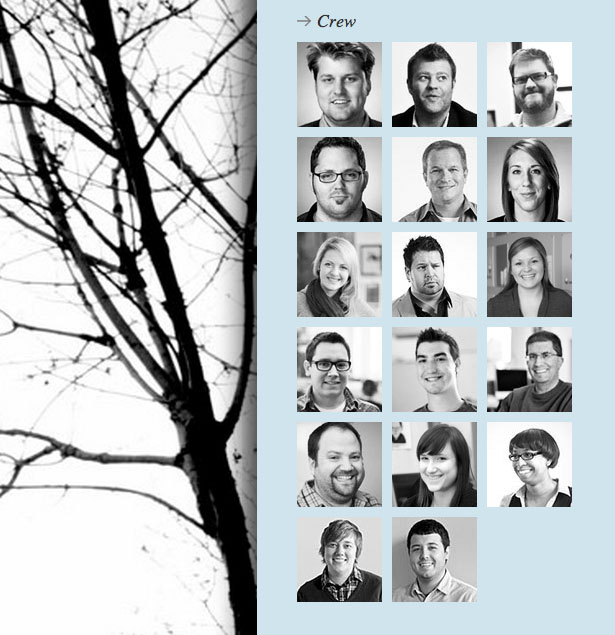 The rest of the Atomicdust staff. From top left to right: Mike Spakowski; Principle/Creative Director, James Dixson; Partner/New Business, Taylor Dixson; Partner/Motion Graphics, Jesse McGowan; Account Director, Kevin Burford; Business Developer, Katie Werges; Senior Designer, Erika Cruse; Account Manager, Jeremy Cox; Motion Graphics Designer, Danielle Hohmeier; Online Account Manager, Tim Gieseking; Developer, Jason Stoff; Designer, Rich Heend; Senior Copywriter, Mike Roberts; Traffic/Project Manager, Beth Porter; Designer, Tara Nesbitt; Online Marketing Intern, Annie McCance; Developer, Jordan Jenkel; Account Executive Intern.
The rest of the Atomicdust staff. From top left to right: Mike Spakowski; Principle/Creative Director, James Dixson; Partner/New Business, Taylor Dixson; Partner/Motion Graphics, Jesse McGowan; Account Director, Kevin Burford; Business Developer, Katie Werges; Senior Designer, Erika Cruse; Account Manager, Jeremy Cox; Motion Graphics Designer, Danielle Hohmeier; Online Account Manager, Tim Gieseking; Developer, Jason Stoff; Designer, Rich Heend; Senior Copywriter, Mike Roberts; Traffic/Project Manager, Beth Porter; Designer, Tara Nesbitt; Online Marketing Intern, Annie McCance; Developer, Jordan Jenkel; Account Executive Intern.
Explaining the process…
One thing Jesse covered is perhaps the most important thing in dealing with clients and the most misunderstood. It seems obvious to me but then again, I’ve held the role of designer, art director, creative director, studio manager, account manager, and wearer-of-many-hats. Dealing with people is hard enough on a daily basis as you drive, shop, and use a public laundromat, so having to maintain a working relationship, bound by a contract, many thousands of dollars, and a process that few, if any, clients understand, is a unique challenge. The process of a project would seem clear to most designers. The client wants this and to get it, we need to first do that, then that, then the other thing, and finally some last minute this and that and the whole project comes to an end. There were days when a client contracted with a designer or design firm and was presented with a final product in a meeting. Done…pay me!
Lately, that’s not the case. Tough economics, competition between creatives and studios, and the cost of a web site with certain collateral projects has clients worried…not that they weren’t worried before but now it has become imperative to waylay the client’s fears with a lot of “hand-holding,” explaining what will happen when, how, and why. There’s nothing wrong with that. In fact, it makes perfect sense. How often do designers complain about a project going awry because a client injects a want at the wrong time or mushrooms the scope of the project? By explaining the process, in detail at the beginning, both parties should understand the milestones and what can and should be expected by BOTH the client and the creative team. As someone at the meeting interjected, “wouldn’t you want a doctor to tell you why and how he/she was going to operate on you?”
The process of a project would seem clear to most designers. The client wants this and to get it, we need to first do that, then that, then the other thing, and finally some last minute this and that and the whole project comes to an end. There were days when a client contracted with a designer or design firm and was presented with a final product in a meeting. Done…pay me!
Lately, that’s not the case. Tough economics, competition between creatives and studios, and the cost of a web site with certain collateral projects has clients worried…not that they weren’t worried before but now it has become imperative to waylay the client’s fears with a lot of “hand-holding,” explaining what will happen when, how, and why. There’s nothing wrong with that. In fact, it makes perfect sense. How often do designers complain about a project going awry because a client injects a want at the wrong time or mushrooms the scope of the project? By explaining the process, in detail at the beginning, both parties should understand the milestones and what can and should be expected by BOTH the client and the creative team. As someone at the meeting interjected, “wouldn’t you want a doctor to tell you why and how he/she was going to operate on you?”
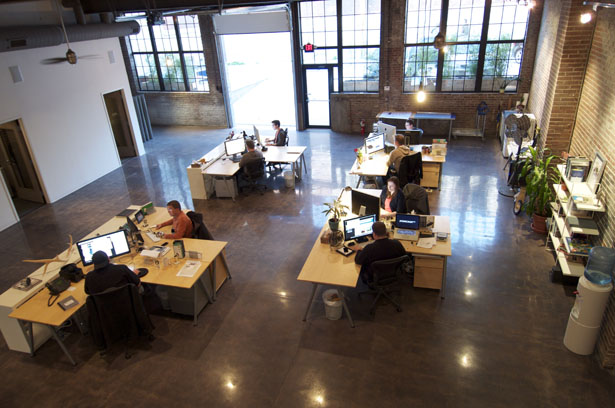 The open space of the converted factory, they now manufacture winning design.
“Having a defined process – and not the type that we brand, hype up and never use – that is engrained in our culture, we not only understand internally exactly how every project will go, but we have the ability to establish the same expectations with our clients,” explains Jesse. “When buying creative services, there is much trepidation around working with free spirited artists. This process removes much of the variability that keep clients awake at night.”
By simply stating, “This is what we do, and this is what it typically costs, is this a good fit?” it eliminates a lot of the needless bartering and wasted time crafting custom proposals for clients. By defining what we do for brands, and what we don’t do, it's become easier for us determine cost,” Mike relates on how this has impacted the studio both in the bottom line of financial considerations such as profit margins and people hours on a project but also on repeat clients as opposed to one-time clients.
The open space of the converted factory, they now manufacture winning design.
“Having a defined process – and not the type that we brand, hype up and never use – that is engrained in our culture, we not only understand internally exactly how every project will go, but we have the ability to establish the same expectations with our clients,” explains Jesse. “When buying creative services, there is much trepidation around working with free spirited artists. This process removes much of the variability that keep clients awake at night.”
By simply stating, “This is what we do, and this is what it typically costs, is this a good fit?” it eliminates a lot of the needless bartering and wasted time crafting custom proposals for clients. By defining what we do for brands, and what we don’t do, it's become easier for us determine cost,” Mike relates on how this has impacted the studio both in the bottom line of financial considerations such as profit margins and people hours on a project but also on repeat clients as opposed to one-time clients.
 Mike concludes, “Design is a valuable services to clients, and conversations about cost shouldn’t be awkward and embarrassing. They also should happen as early as possible.”
Mike concludes, “Design is a valuable services to clients, and conversations about cost shouldn’t be awkward and embarrassing. They also should happen as early as possible.”
“Enigmatic wizardry?”
Naturally, there are designers who believe that a client should just trust the designer to deliver the best possible product without explaining the process or any interference. As one attendee brought up during the question and answer portion of the evening, he thought that design should be almost kept secret from the client with what he termed, “enigmatic wizardry.” “Dumbledork,” as he will now be known to the rest of the design group for this profound statement, is undoubtedly one of the introverts referred to in the beginning of this article. Probably more so now that he has been made a public laughing stock. It’s another bit of proof that not every creative is able to deal with clients as does Mr. McGowan and Mr. Spakowski. The idea of keeping our “magical” designing secret is ridiculous, if it was really ever a practice. Transparency is naturally the best way to run a project, from both the creative and client sides, as well as raising trust from both parties and assuring future work and recommendations of the studio’s professional abilities.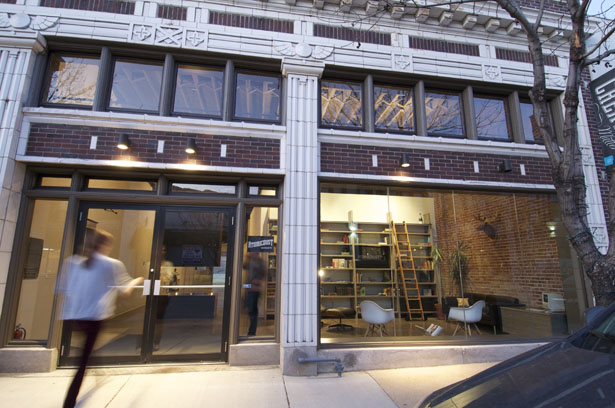 The front of Atomicdust. Transparent windows and work process.
Jesse adds, “the design profession is shrouded in enough mystery already. We try to operate our business as transparently as possible, with our clients, staff, and peers. We can all learn a lot from each other, and closing yourself off from the world will date you more than protect you. Share what you know, inspire others, and aim to push our profession forward.”
The front of Atomicdust. Transparent windows and work process.
Jesse adds, “the design profession is shrouded in enough mystery already. We try to operate our business as transparently as possible, with our clients, staff, and peers. We can all learn a lot from each other, and closing yourself off from the world will date you more than protect you. Share what you know, inspire others, and aim to push our profession forward.”
Commoditization
Jesse spoke on an issue called “commoditization.” He explains the meaning: “Process allows designers and agencies to streamline their internal efforts, and helps clients have a better understanding of what they’re buying. But on a more broad scale, it allows us to fight the commoditization of our industry. Let’s be honest, designers are a dime a dozen in a client’s eyes. The market is so saturated that our clients are losing the ability to distinguish between us (designers), resulting in competition based on price rather than talent. Bottom line: they think that all designers are the same, so they hire the cheapest one possible.”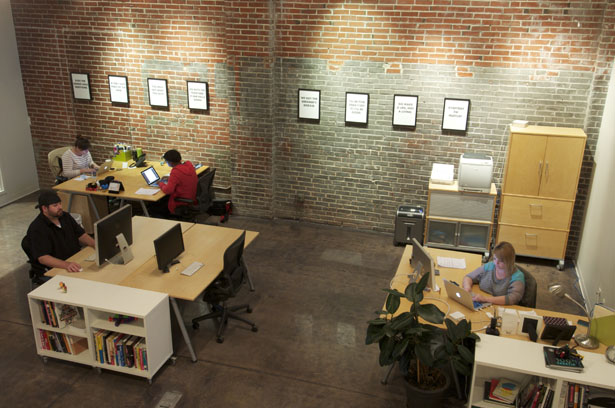 “Process represents a chance to stand out,” he continues. “It demonstrates that a designer understands what it takes for he/she to consistently do good work, and depending on the process employed, may allow them to produce more strategic, educated creative than their peers. Clients will notice the difference and usually pay for it, too.”
“Process represents a chance to stand out,” he continues. “It demonstrates that a designer understands what it takes for he/she to consistently do good work, and depending on the process employed, may allow them to produce more strategic, educated creative than their peers. Clients will notice the difference and usually pay for it, too.”
Final thoughts
“Ours is an industry that most of us are not truly prepared to enter", states Jesse. “We may be schooled as designers. We may be passionate about our craft. But one day we will all wake up and find that we are under-prepared for what our day has in store. We will realize that the business of graphic design is just as much about relationships, people management, financial decisions, networking and selling as it is about designing. Many will spin their wheels and burn out. The smart designers will adapt and in all likelihood forge the next mold for smart, cutting edge agencies.” Check out Atomicdust’s blog and sign up for their monthly newsletter. Follow them on Twitter and FacebookSpeider Schneider
Speider Schneider is a former member of The Usual Gang of Idiots at MAD Magazine and has designed products for Disney/Pixar, Warner Bros., Harley-Davidson, ESPN, Mattel, DC and Marvel Comics, Cartoon Network and Nickelodeon among other notable companies. Speider is a former member of the board for the Graphic Artists Guild, co-chair of the GAG Professional Practices Committee and a former board member of the Society of Illustrators. Follow him on Twitter @speider or add him on Google+
Read Next
3 Essential Design Trends, November 2024
Touchable texture, distinct grids, and two-column designs are some of the most trending website design elements of…
20 Best New Websites, October 2024
Something we’re seeing more and more of is the ‘customizable’ site. Most often, this means a button to swap between…
Exciting New Tools for Designers, October 2024
We’ve got goodies for designers, developers, SEO-ers, content managers, and those of you who wear multiple hats. And,…
15 Best New Fonts, September 2024
Welcome to our roundup of the best new fonts we’ve found on the web in the previous four weeks. In this month’s edition…
By Simon Sterne
3 Essential Design Trends, October 2024
This article is brought to you by Constantino, a renowned company offering premium and affordable website design
You…
A Beginner’s Guide to Using BlueSky for Business Success
In today’s fast-paced digital world, businesses are always on the lookout for new ways to connect with their audience.…
By Louise North
The Importance of Title Tags: Tips and Tricks to Optimize for SEO
When it comes to on-page SEO, there’s one element that plays a pivotal role in both search engine rankings and user…
By Simon Sterne
20 Best New Websites, September 2024
We have a mixed bag for you with both minimalist and maximalist designs, and single pagers alongside much bigger, but…
Exciting New Tools for Designers, September 2024
This time around we are aiming to simplify life, with some light and fast analytics, an all-in-one productivity…
3 Essential Design Trends, September 2024
September's web design trends have a fun, fall feeling ... and we love it. See what's trending in website design this…
Crafting Personalized Experiences with AI
Picture this: You open Netflix, and it’s like the platform just knows what you’re in the mood for. Or maybe you’re…
By Simon Sterne
15 Best New Fonts, August 2024
Welcome to August’s roundup of the best fonts we’ve found over the last few weeks. 2024’s trend for flowing curves and…
By Ben Moss















